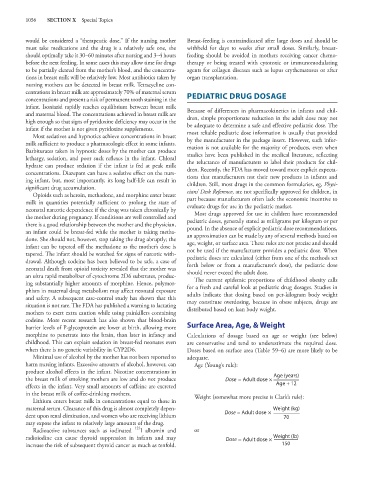Page 1070 - Basic _ Clinical Pharmacology ( PDFDrive )
P. 1070
1056 SECTION X Special Topics
would be considered a “therapeutic dose.” If the nursing mother Breast-feeding is contraindicated after large doses and should be
must take medications and the drug is a relatively safe one, she withheld for days to weeks after small doses. Similarly, breast-
should optimally take it 30–60 minutes after nursing and 3–4 hours feeding should be avoided in mothers receiving cancer chemo-
before the next feeding. In some cases this may allow time for drugs therapy or being treated with cytotoxic or immunomodulating
to be partially cleared from the mother’s blood, and the concentra- agents for collagen diseases such as lupus erythematosus or after
tions in breast milk will be relatively low. Most antibiotics taken by organ transplantation.
nursing mothers can be detected in breast milk. Tetracycline con-
centrations in breast milk are approximately 70% of maternal serum PEDIATRIC DRUG DOSAGE
concentrations and present a risk of permanent tooth staining in the
infant. Isoniazid rapidly reaches equilibrium between breast milk
and maternal blood. The concentrations achieved in breast milk are Because of differences in pharmacokinetics in infants and chil-
high enough so that signs of pyridoxine deficiency may occur in the dren, simple proportionate reduction in the adult dose may not
infant if the mother is not given pyridoxine supplements. be adequate to determine a safe and effective pediatric dose. The
Most sedatives and hypnotics achieve concentrations in breast most reliable pediatric dose information is usually that provided
milk sufficient to produce a pharmacologic effect in some infants. by the manufacturer in the package insert. However, such infor-
Barbiturates taken in hypnotic doses by the mother can produce mation is not available for the majority of products, even when
lethargy, sedation, and poor suck reflexes in the infant. Chloral studies have been published in the medical literature, reflecting
hydrate can produce sedation if the infant is fed at peak milk the reluctance of manufacturers to label their products for chil-
concentrations. Diazepam can have a sedative effect on the nurs- dren. Recently, the FDA has moved toward more explicit expecta-
ing infant, but, most importantly, its long half-life can result in tions that manufacturers test their new products in infants and
significant drug accumulation. children. Still, most drugs in the common formularies, eg, Physi-
Opioids such as heroin, methadone, and morphine enter breast cians’ Desk Reference, are not specifically approved for children, in
milk in quantities potentially sufficient to prolong the state of part because manufacturers often lack the economic incentive to
neonatal narcotic dependence if the drug was taken chronically by evaluate drugs for use in the pediatric market.
the mother during pregnancy. If conditions are well controlled and Most drugs approved for use in children have recommended
there is a good relationship between the mother and the physician, pediatric doses, generally stated as milligrams per kilogram or per
an infant could be breast-fed while the mother is taking metha- pound. In the absence of explicit pediatric dose recommendations,
done. She should not, however, stop taking the drug abruptly; the an approximation can be made by any of several methods based on
infant can be tapered off the methadone as the mother’s dose is age, weight, or surface area. These rules are not precise and should
tapered. The infant should be watched for signs of narcotic with- not be used if the manufacturer provides a pediatric dose. When
drawal. Although codeine has been believed to be safe, a case of pediatric doses are calculated (either from one of the methods set
neonatal death from opioid toxicity revealed that the mother was forth below or from a manufacturer’s dose), the pediatric dose
an ultra rapid metabolizer of cytochrome 2D6 substrates, produc- should never exceed the adult dose.
ing substantially higher amounts of morphine. Hence, polymor- The current epidemic proportions of childhood obesity calls
phism in maternal drug metabolism may affect neonatal exposure for a fresh and careful look at pediatric drug dosages. Studies in
and safety. A subsequent case-control study has shown that this adults indicate that dosing based on per-kilogram body weight
situation is not rare. The FDA has published a warning to lactating may constitute overdosing, because in obese subjects, drugs are
mothers to exert extra caution while using painkillers containing distributed based on lean body weight.
codeine. More recent research has also shown that blood-brain
barrier levels of P-glycoprotein are lower at birth, allowing more Surface Area, Age, & Weight
morphine to penetrate into the brain, than later in infancy and Calculations of dosage based on age or weight (see below)
childhood. This can explain sedation in breast-fed neonates even are conservative and tend to underestimate the required dose.
when there is no genetic variability in CYP2D6. Doses based on surface area (Table 59–6) are more likely to be
Minimal use of alcohol by the mother has not been reported to adequate.
harm nursing infants. Excessive amounts of alcohol, however, can Age (Young’s rule):
produce alcohol effects in the infant. Nicotine concentrations in
the breast milk of smoking mothers are low and do not produce Dose = Adult dose × Age (years)
effects in the infant. Very small amounts of caffeine are excreted Age + 12
in the breast milk of coffee-drinking mothers. Weight (somewhat more precise is Clark’s rule):
Lithium enters breast milk in concentrations equal to those in
maternal serum. Clearance of this drug is almost completely depen- Weight (kg)
dent upon renal elimination, and women who are receiving lithium Dose = Adult dose × 70
may expose the infant to relatively large amounts of the drug.
Radioactive substances such as iodinated 125 I albumin and or
radioiodine can cause thyroid suppression in infants and may Dose = Adult dose × Weight (lb)
increase the risk of subsequent thyroid cancer as much as tenfold. 150

